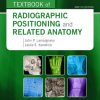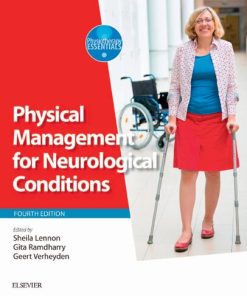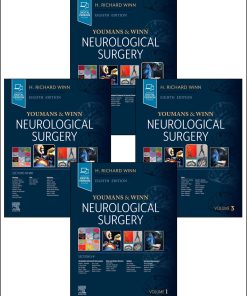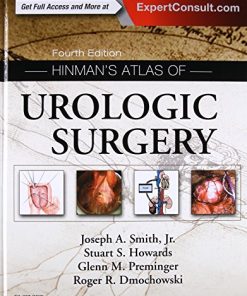Principles of Neurological Surgery 4th Edition by Richard Ellenbogen, Laligam Sekhar, Neil Kitchen 0323461283 9780323461283
$50.00 Original price was: $50.00.$25.00Current price is: $25.00.
Principles of Neurological Surgery 4th Edition by Richard G. Ellenbogen, Laligam N Sekhar, Neil Kitchen – Ebook PDF Instant Download/DeliveryISBN: 0323461283, 9780323461283
Full download Principles of Neurological Surgery 4th Edition after payment.

Product details:
ISBN-10 : 0323461283
ISBN-13 : 9780323461283
Author: Richard G. Ellenbogen, Laligam N Sekhar, Neil Kitchen
Perfect for anyone considering or training in this challenging specialty, Principles of Neurological Surgery, 4th Edition, by Drs. Richard G. Ellenbogen, Laligam N. Sekhar, and Neil Kitchen, provides a clear, superbly illustrated introduction to all aspects of neurosurgery–from general principles to specific techniques. Thorough updates from leading authors ensure that you’ll stay abreast of the latest advances in every area of neurosurgery, including pre- and post-operative patient care, neuroradiology, pediatric neurosurgery, neurovascular surgery, trauma surgery, spine surgery, oncology, pituitary adenomas, cranial base neurosurgery, image-guided neurosurgery, treatment of pain, epilepsy surgery, and much more.
Principles of Neurological Surgery 4th Table of contents:
1 Cerebrovascular Cases
2 Cranial Nerve Compression Syndromes
3 Skull Base and Other Tumors
Videos
Part 1 General Overview
1 Landmarks in the History of Neurosurgery
Prehistoric Period: the Development of Trephination
Egyptian and Babylonian Medicine: Embryonic Period
Greek and Early Byzantine Period: the Origins of Neurosurgery
Arabic and Medieval Medicine: Scholarship With Intellectual Somnolence
Sixteenth Century: Anatomic Exploration
Seventeenth Century: Origins of Neurology
Eighteenth Century: Adventurous Surgeons
Nineteenth and Twentieth Centuries: Anesthesia, Antisepsis, and Cerebral Localization
Conclusion
References
2 Challenges in Global Neurosurgery
Challenges in the Work Environment
Managing Specific Conditions
Epilepsy, Stereotactic, and Functional Neurosurgery
Conclusions and Recommendations
References
3 Clinical Evaluation of the Nervous System
Neurologic History
Focal Cortical Signs
Pyramidal Tract
Extrapyramidal System
Cranial Nerves
Cerebellum
Spinal Cord, Nerve Roots, and Muscles
The Pediatric Patient
Neuro-Ophthalmology
Ancillary Diagnostic Tests
Diagnosis and Investigation of Cerebral Tumors
Headache
Vascular Diseases
Hysteria and Malingering
References
4 Principles of Modern Neuroimaging
Principles
Clinical Imaging
Summary
References
5 Neuroanesthesia and Monitoring for Cranial and Complex Spinal Surgery
Preanesthetic Evaluation
Neurophysiology and Anesthetic Neuropharmacology
Anesthesia for Craniotomy
Airway Management in Neuroanesthesia
Osmotherapy and Diuretics
Burst Suppression
Hemodynamic Management in Cerebrovascular Diseases
Hypothermia
Glucose Management
Intraoperative Neuromonitoring
Anesthetic Considerations for Spine Surgery
Intraoperative Blood Loss
Postoperative Visual Loss
Pain Management
Enhanced Recovery After Surgery Pathways
Fluid Management in Neurosurgical Patients
Emergence From Anesthesia
References
6 Surgical Positioning, Navigation, Important Surgical Tools, Craniotomy, and Closure of Cranial and Spinal Wounds
Surgical Positioning
Cranial Surgery Position
Neuronavigation
Important Surgical Tools
Craniotomy
Closure of Cranial and Spinal Wounds
Conclusion
References
Part 2 Pediatric Neurosurgery
7 Spinal Dysraphism and Tethered Spinal Cord
Myelomeningocele
Intrauterine Myelomeningocele Repair
Occult Spinal Dysraphism and the Tethered Cord Syndrome
Lipomyelomeningocele
Diastematomyelia and the Split Cord Malformations
Anterior Sacral Meningocele
Congenital Dermal Sinus and Hypertrophied Filum Terminale
Sacral Agenesis, Myelocystocele, and Cloacal Exstrophy
Conclusions
Acknowledgments
References
8 Hydrocephalus in Children
Introduction
Intracranial Pressure
Cerebrospinal Fluid Dynamics and Pathophysiology
Classification of Hydrocephalus
Treatment Outcome
Conclusions and Future Directions
References
9 Diagnosis and Surgical Options for Craniosynostosis
History
Epidemiology
Genetic and Etiologic Factors
Anatomic and Pathologic Considerations
Diagnostic Evaluation and Imaging
Therapeutic Considerations
Clinical Presentation/Therapeutic Considerations
Future Directions
References
10 Chiari Malformations and Syringohydromyelia
Chiari I Malformation
Chiari II Malformation
Syringohydromyelia
Summary
References
11 Posterior Fossa and Brainstem Tumors in Children
Posterior Fossa Tumors
References
12 Craniopharyngiomas
Introduction
Epidemiology
Embryology
Anatomy
Pathology
Radiology
Presentation
Endocrine Assessment
Neuro-Ophthalmologic Assessment
Treatment Planning
Surgical Techniques
Perioperative Management and Potential Complications
Adjuvant and Novel Therapies
Long-Term Outcomes
Recurrence
Conclusion
References
13 All Other Brain Tumors in Pediatrics
Introduction
Conclusion
References
14 Nontraumatic Stroke in Children
Introduction
Epidemiology
Presentation
Imaging Evaluation and Exposure to Ionizing Radiation
Hemorrhagic Stroke Etiologies
Ischemic Stroke Etiologies
Conclusions
References
Part 3 Vascular Neurosurgery
15 Medical and Surgical Treatment of Cerebrovascular Occlusive Disease
Introduction
Atherosclerotic Disease
Moyamoya
Dissection
Operative Techniques
References
16 General Principles for the Management of Ruptured and Unruptured Intracranial Aneurysms
Introduction
Epidemiology
Pathogenesis
Natural History
Clinical Presentation
Diagnosis
Subarachnoid Hemorrhage
Treatment of Intracranial Aneurysms
Treatment of Unruptured Aneurysms
Treatment of Ruptured Aneurysms
Conclusion
References
17 Anterior Circulation Aneurysms
Introduction
Imaging
Anatomy
Internal Carotid Artery
The Surgical Approach to Anterior Circulation Aneurysms and General Tenets
Anterior Circulation Aneurysm Subtypes
Proximal Internal Carotid Artery Aneurysms
Posterior Communicating and Anterior Choroidal Artery Aneurysms
Middle Cerebral Artery Aneurysms
Anterior Communicating Artery Aneurysms
Pericallosal Aneurysms
References
18 Surgery for Posterior Circulation Aneurysms
Background
Superior Cerebellar Artery Aneurysms
Basilar Artery (Apex) Aneurysms
Posterior Inferior Cerebellar Artery Aneurysms
Other Aneurysms of the Posterior Circulation
Controversy
References
19 Complex Aneurysms and Cerebral Bypass
Indications for Bypass
Preoperative Planning
Technique
Outcomes
References
20 Vascular Malformations (Arteriovenous Malformations and Dural Arteriovenous Fistulas)
Introduction
Classification and Definitions
Diagnostic Radiology
Angiography
Epidemiology and Natural History
Clinical Presentation of Arteriovenous Malformations
Pathogenesis and Development of Arteriovenous Malformations
Molecular Biology and Genetics
Physiology
Pediatric Arteriovenous Malformations
Spinal Vascular Malformations
Treatment
Summary
Acknowledgments
References
21 Cavernous Malformations of the Brain and Spinal Cord
Description
Natural History
Management Options
Management Decisions
Special Considerations
Conclusion
References
22 Spontaneous Intracerebral Hemorrhage
Background and Epidemiology
Pathophysiology
Etiology
Signs and Symptoms
Natural History
Diagnosis
Treatment
References
23 Endovascular Treatment of Acute Stroke and Occlusive Cerebrovascular Disease
Introduction
Epidemiology
Pathophysiology
Clinical Findings
Diagnostic Imaging
Endovascular Treatment of Acute Ischemic Stroke
Intracranial Atherosclerotic Disease
Endovascular Treatment of Carotid Disease
Conclusion
References
24 Endovascular Treatment of Intracranial Aneurysms
Introduction
Clip or Coil?
Aneurysm Morphology
Dome-to-Neck Ratio
Aspect Ratio
Neck Width
Dome Size
Future Directions
Conclusion
References
Part 4 Trauma
25 Closed Head Injury
Classification
Intracranial Pressure
General Management and Initial Evaluation of Traumatic Brain Injury
Severe Traumatic Brain Injury
Medical Therapy
Intracranial Pressure Monitoring
Surgical Therapy
Special Consideration: Surgery for Diffuse Brain Injury or Intracranial Pressure Control
Prognosis
Long-Term Sequelae of Brain Injury
Acknowledgments
References
26 Critical Care Management of Neurosurgical Patients
Cerebral Homeostasis
Initial Assessment of Critically Ill Neurosurgical Patients
Basic Concepts of Management in Neurocritical Care Units
Principles of Neurologic Monitoring
Specifics of General Care in Critically Ill Neurosurgical Patients
Management of Specific Neurosurgical Pathology
Brain Death
Conclusion
References
27 Penetrating Brain Injury
Historical Background
Prognosis
Pathophysiology
Mechanisms of Penetrating Brain Injury
Management Recommendations in the Setting of Penetrating Brain Injuries
Endovascular Considerations
Conclusion
References
28 Traumatic Skull and Facial Fractures
Skull Fractures
Facial Injuries
Facial Fracture Diagnosis and Management by Anatomic Region
References
Part 5 The Spine
29 Injuries to the Cervical Spine
Introduction
Biomechanics and Pathophysiology
Classification of Cervical Spine Injuries
References
30 Thoracolumbar Spine Fractures
Biomechanics
Radiographic Evaluation
Classification of Thoracolumbar Fractures
Fracture Management
Summary
References
31 Intradural Extramedullary and Intramedullary Spinal Cord Tumors
Intradural Extramedullary Tumors
Epidemiology
Clinical Presentation
Imaging
Surgery
Spinal Meningiomas
Nerve Sheath Tumors
Paragangliomas
Dermoid/Epidermoid Lesions
Lipomas
Intradural Lesions That Mimic Tumors
Adjuvant Treatments
Intramedullary Spinal Cord Tumors
Ependymomas
Astrocytomas
Hemangioblastomas
Gangliogliomas
Intramedullary Metastases
References
32 Management of Spinal Metastatic Tumors
Introduction
Presentation
Imaging and Workup
Management Decisions
Surgical Intervention
Radiation Therapy
Adjuvant Therapies
Medication and Analgesia
References
33 Spinal Cord Injury
Introduction
Epidemiology
Pathophysiology
Clinical Management
Neuroregenerative Strategies
Conclusions
References
34 Craniovertebral Junction
Introduction
Craniovertebral “Anomalies” or “Alterations”
Atlantoaxial Dislocation
Basilar Invagination
Degenerative Arthritis
References
35 Degenerative Spinal Disease (Cervical)
Degenerative Spine Disease (Cervical)
Degenerative Conditions and Treatment
Conclusion
References
36 Degenerative Spinal Disease (Lumbar)
Lumbar Spine Disease
References
37 Pediatric and Adult Scoliosis
Part I Scoliosis in the Pediatric Patient
Part II Adult Scoliosis and Spinal Deformity
References
Part 6 Tumors
38 Low-Grade Gliomas
Overview
Epidemiology
Imaging
Intraoperative Imaging With Image Guidance, Ultrasonography, Computed Tomography, and Magnetic Resonance Imaging
Prognosis
Conclusions
References
39 High-Grade Gliomas
Introduction
Management
Prognosis
Frontiers
Conclusion
References
40 Brain Metastasis
Overview
Imaging a Brain Metastasis
Treatment Options for a Single Metastasis
Conclusions for Single Metastasis
Future Directions
Treatment Options for Multiple Cerebral Metastases
Conclusions
References
41 Convexity and Parasagittal Versus Skull Base Meningiomas
Meningiomas
Epidemiology
Treatment Options
Embolization
Surgical Resection
Fractionated External Beam Radiation Therapy (EBRT)
Stereotactic Radiosurgery
Chemotherapy
Classification
Presentation
Diagnosis
Future Perspectives
Conclusions
References
42 Pineal Region Tumors
Introduction
Anatomy
Pineal Cysts
Pineal Region Tumors
Presentation
Hydrocephalus Management
Tumor Subtypes
Tumor Markers
Surgical Approaches: A Historical Review
Acknowledgments
References
43 Cerebellopontine Angle Tumors
History of Cerebellopontine Angle Surgery
Cerebellopontine Angle Anatomy
Surgical Approaches to the Cerebellopontine Angle
Mass Lesions of the Cerebellopontine Angle
Radiosurgery for Cerebellopontine Angle Masses
References
44 Pituitary Tumors: Diagnosis and Management
Pituitary Gland
Epidemiology
Classification
Nonfunctioning Pituitary Adenomas
Presentation
Diagnosis
Functioning Pituitary Adenomas
Pituitary Apoplexy
Pediatric Adenomas
Conclusion
References
45 Endoscopic Approaches to Ventricular Tumors and Colloid Cysts
Introduction
History
Instrumentation
Principles
Introduction to Colloid Cysts
Management of Colloid Cysts
Neurocysticercotic Cysts
Miscellaneous Cysts
Intraventricular Tumor Resection
Biopsy of Intraventricular Tumors
Endoscope-Assisted Microsurgery
Conclusion and Future Directions
References
46 Microsurgical Approaches to the Ventricular System
Microsurgical Anatomy
Pathologic Entities
Preoperative Planning and General Surgical Considerations
Craniotomy Flap and Cortical Incisions
Anterior Transcortical Approach
Approach to the Temporal Horn
Posterior Transcortical Approaches
Interhemispheric Transcallosal and Posterior Third Ventricle Approaches
Combined Endoscope-Assisted Microsurgical Approach to the Lateral and Third Ventricles
Approach to the Fourth Ventricle
Postoperative Deficits and Complication Avoidance
Future Directions
Conclusion
References
47 Skull Base Tumors: Evaluation and Microsurgery
Introduction
Evaluation of Skull Base Tumors
Surgical Approaches
Complications of Skull Base Approaches
Conclusions
References
48 Endoscopic Approaches to Skull Base Lesions
Introduction
Historical Overview
Skull Base Anatomy: The Endonasal Perspective
Instruments and Tools
Endoscopic Endonasal Approaches to the Skull Base
Results and Complications
Conclusions
References
49 Jugular Foramen Tumors
Jugular Foramen
Jugular Foramen Tumors
Paragangliomas
Schwannoma
Management
Complications Associated With Jugular Foramen Tumor Resection
References
Part 7 Radiosurgery and Radiotherapy
50 Application of Current Radiation Delivery Systems and Radiobiology
Physics of Radiotherapy
Biology of Radiation Therapy
Importance of Neurosurgery in the History of Radiosurgery
Contemporary Radiation Delivery Systems
Conclusions
References
51 Radiosurgery of Central Nervous System Tumors and Arteriovenous Malformations
Central Nervous System Tumors
Arteriovenous Malformations
Summary
References
52 Description of Proton Therapy
Rationale for Proton Therapy
Medulloblastoma
Ependymoma
Craniopharyngioma
Low-Grade Glioma
High-Grade Glioma
Meningiomas
Pituitary Adenoma
Chordomas and Chondrosarcomas
Summary
References
Part 8 Functional Pain
53 Trigeminal Neuralgia
Introduction and History
Pathogenesis
Clinical Features and Diagnosis
Treatment Modalities and Results
Summary and Treatment Algorithm
References
54 Spasticity
Introduction
Nonsurgical Management
Orthopedic Surgery
Intrathecal Baclofen
Intraventricular Baclofen
Selective Dorsal Rhizotomy
Conclusion
References
55 Surgery for Temporal Lobe Epilepsy
Introduction
Common Temporal Lobe Epilepsy Syndromes
Presurgical Evaluation
Surgical Technique
Outcomes and Complications
Conclusion
References
56 Extratemporal Procedures and Hemispherectomy for Epilepsy
General Features
Etiologies of Extratemporal Lobe Epilepsy
Evaluation of Surgery (Fig. 56.2)
Surgical Technique
Laser Interstitial Thermal Therapy
Clinical Outcomes and Complications
Conclusion
References
57 Deep Brain Stimulation for Movement Disorders
Introduction
History
Neural Motor Control Systems
Overview of Neuroanatomy Relevant to Movement Disorder Surgery
Mechanism of Action of Deep Brain Stimulation
Deep Brain Stimulation in the Management of Movement Disorders
Surgical Approach to Deep Brain Stimulation
Patient Follow-Up After Deep Brain Stimulation
Advances in Deep Brain Stimulation Hardware
Ethics
Conclusion
References
58 Stereotactic Functional Neurosurgery for Mental Health Disorders, Pain, and Epilepsy
Introduction
Mental Health Disorders
Pain
Summary
References
Part 9 Miscellaneous
59 Surgical Management of Infection of the Central Nervous System, Skull, and Spine
Introduction
Management of Brain Abscess and Epidural and Subdural Empyema
Special Infection Problems in the Central Nervous System
Surgical Management of Spine Infections
Notes on the Management of Postoperative Infection
Postoperative Medical Management
References
60 Hydrocephalus in Adults
Pathogenesis
Etiology and Classification
Epidemiology
Diagnosis
Differential Diagnosis
Investigations
Postoperative Management and Follow-up
Complications
Idiopathic Intracranial Hypertension
References
61 Management of Peripheral Nerve Injuries
Preamble: Peripheral Nerve Injury
Basic Types of Nerve Injuries
General Assessment of Patient With Nerve Injury
Basic Microscopic Anatomy and Physiology of Peripheral Nerve (Classification)
History of Injury
Physical Examination and Clinical Associations
Supplementary Investigation and Workup
Treatment of Nerve Injury: Strategies and Options
Post-op Management
Outcomes
References
62 Entrapment Neuropathies and Peripheral Nerve Tumors
Definition
Peripheral Neuropathy and Entrapment Neuropathy
Pathologic Description/Mechanism of Nerve Injury in Entrapment Neuropathy
Peripheral Nerve Tumors
References
63 Prehospital Neurotrauma
Introduction
Mechanisms of Injury
Sports-Related “Concussion”
On-Scene Management
C-Spine Protection
Management of the Cerebrally Agitated Patient
Initial Airway Management
Intubation of Head-Injured Patients
Optimization of Brain Perfusion
Ventilation
Osmotic Diuretics
Cooling
Traumatic Brain Injury and Coagulopathy
Brain Injury–Induced Coagulopathy
Drug-Induced Coagulopathy in Traumatic Brain Injury
Triage and Transfer of Patients
Future Possibilities
Conclusion
People also search for Principles of Neurological Surgery 4th:
what are the principles of surgery
basic principles of surgery
what is neurological surgery
principles of neurosurgery
principles of neuroanesthesia
Tags: Neurological Surgery, Principles, Richard Ellenbogen, Laligam Sekhar, Neil Kitchen
You may also like…
Medicine - Clinical Medicine
Principles and Practice of Surgery 7th Edition O. James Garden
Medicine - Clinical Medicine
Medicine - Surgery
Medicine - Neurology
Neurological Clinical Examination: A Concise Guide 4th Edition John Morris
Medicine - Surgery











